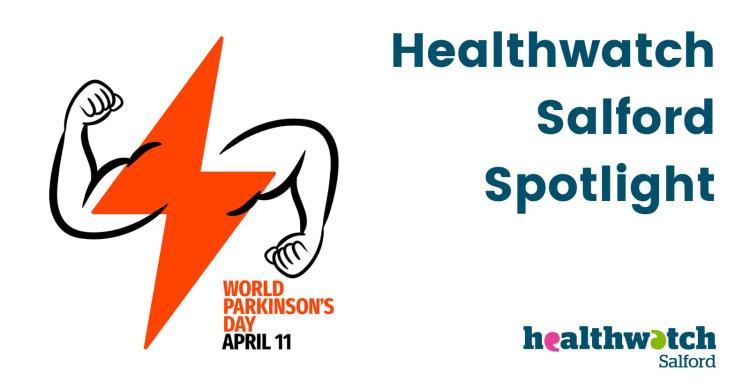Healthwatch Salford Spotlight: World Parkinson's Day

Parkinson's is a progressive neurological condition. This means that it causes problems in the brain and gets worse over time.
People with Parkinson's don't have enough of the chemical dopamine in their brain because some of the nerve cells that make it have stopped working.
Around 153,000 people live with Parkinson’s in the UK. And it's the fastest growing neurological condition in the world.
For more information on the awareness day visit the Parkinson's UK website, or follow them on social media:
-
Learn more about Parkinson's.
1. THERE IS STILL NO CURE FOR PARKINSON'S.
-
Parkinson's disease is a progressive and debilitating neurological disorder affecting millions of people worldwide. Despite significant advancements in treatment, there is still no known cure for the disease, and those living with Parkinson's must navigate its ongoing impact on their health and well-being.
-
2. IT IS THE WORLD’S FASTEST GROWING BRAIN DISEASE.
Parkinson's disease is the fastest growing and the second most prevalent neurological condition, affecting an estimated 10 million people worldwide.
From 1990 to 2015, the number of people with Parkinson disease doubled to over 6 million. Driven principally by aging, this number is projected to double again to over 12 million by 2040. Additional factors, including increasing longevity, declining smoking rates, and increasing industrialization, could raise the burden to over 17 million. For most of human history, Parkinson has been a rare disorder. However, demography and the by-products of industrialization have now created a Parkinson pandemic that will require heightened activism, focused planning, and novel approaches.
-
3. WE’RE SEEING THE START OF A PARKINSON’S PANDEMIC.
-
The book Ending Parkinson's Disease: A Prescription for Action calls Parkinson's a man-made pandemic. This means that Parkinson's is a disease that affects a large number of people across the world, much like a pandemic. Unlike pandemics caused by viruses or bacteria, Parkinson's is caused by factors such as urbanization, aging populations, globalization, and the widespread availability of unhealthy products like fast food. Parkinson's is found all over the world, and its rate is increasing almost everywhere. It's similar to an infectious pandemic because it seems to be spreading as industrialization expands.
-
4. ANYONE CAN BE DIAGNOSED WITH PARKINSON’S DISEASE.
-
Parkinson's disease is a condition that can affect anyone, regardless of their gender, ethnicity, age, or where they live. Even young people can develop Parkinson's, with about 10 to 20 percent of people experiencing symptoms before they turn 50. This is called "young onset," and while treatments are similar, the disease may affect younger people differently. Scientists are currently studying the causes of young-onset Parkinson's to better understand the condition. Other studies have suggested that Parkinson's may affect more men than women, although the reasons for this are not yet clear. Researchers are working to understand the factors that may increase a person's risk of developing Parkinson's, so that we can better prevent and treat this disease.
-
5. PARKINSON'S IS A FULL BODY DISEASE.
-
Parkinson's disease is not just a motor disorder that affects movement. In fact, there are over 40 potential symptoms that can impact a person's quality of life, including issues with mood, sleep, pain, gut health, and constipation. While tremors and other motor symptoms are well-known, many other symptoms, such as depression and loss of speech, can be invisible to others, making those with the disease feel even more isolated.
-
6. LIVING WITH THE DISEASE MEANS LIVING WITH ITS STIGMA.
-
Parkinson's disease is a condition that is often misunderstood, which can leave people with Parkinson's feeling vulnerable and discriminated against. Unfortunately, people with Parkinson's often earn less money than their peers and face difficulty obtaining and retaining employment, despite their qualifications and abilities. Beyond financial challenges, people with Parkinson's may also face social stigma and discrimination. Due to the symptoms of the disease, they may be mistaken for being intoxicated or under the influence of drugs, which can be embarrassing and hurtful. In some countries, they may even be cursed by witches or other superstitions. Parkinson's can also cause constant pain, as well as impact a person's voice, confidence, and ability to control their limbs and automatic functions.
-
7. THE GOLD STANDARD TREATMENT IS APPROACHING RETIREMENT AGE
-
The last great breakthrough for Parkinson's came with the discovery of levodopa in the 1960s. Levodopa remains the gold standard for Parkinson's treatment to this day. It was first used to treat Parkinson's patients in 1967 and has since provided significant relief for many of the disease's symptoms, improving patients' quality of life. Levodopa is actually converted to dopamine in the brain, which helps to compensate for the depleted supply of dopamine that's seen in Parkinson's disease.
-
8. WE CAN MAKE A DIFFERENCE: HOW ADVOCACY LED TO PROGRESS IN BANNING DANGEROUS CHEMICALS
-
Progress is being made in the fight against dangerous chemicals that have been linked to Parkinson's disease. Paraquat, Trichlorethylene (TCE), and Chlorpyrifos are among the toxins that have been identified as increasing the risk of developing this debilitating disease.
Paraquat is considered the deadliest chemical in US agriculture and is thought to increase the risk of Parkinson's by up to 500%. Despite being banned in almost 60 countries, more than 8 billion pounds of paraquat are still sprayed on crops annually in the United States.
Following a petition signed by over 100,000 advocates and organizations, and thousands of calls and emails to Congress, the United States Environmental Protection Agency (EPA) agreed in December 2022 to reconsider the evidence linking paraquat to brain damage and other harm. Controversially, the United Kingdom banned TCE in 2007 but continues to manufacture the herbicide and export it.
TCE is used in dishwashing products, as a solvent in brake and parts cleaning, recycling, and disposal, and for spot removal at dry cleaners. Until 1977, it was even used to decaffeinate coffee and extract oils from vegetables. In January 2023, the EPA declared that TCE poses an "unreasonable risk to health" for the public. In March 2023, Ray Dorsey, MD, and colleagues published an article in the Journal of Parkinson's Disease questioning whether TCE is a silent cause of Parkinson's.
Chlorpyrifos is an insecticide that was banned in 2022 from use on any food sold in the U.S. for the first time since it was approved in 1965. The EPA's ruling came down on April 20, 2023. However, Canada is still allowing Canadian-grown foods to sell products with the toxic chemical until December 2023.
Breathing or ingesting chlorpyrifos can result in a variety of nervous system effects, ranging from headaches, blurred vision, and salivation to seizures, Parkinson's, coma, and even death, depending on the amount and length of exposure. Currently, government reviews of these chemicals are ongoing in several countries, with possible bans or restrictions on their use under consideration.
-
9. PARKINSON'S RATES ON THE RISE
According to a new study published in the journal Neurology, the incidence of Parkinson's disease in the United States is 50% higher than previous estimates with 90,000 new diagnosis each year. The study found that the incidence rate was 1.5 times higher in men than in women.
In Canada, the reporting rates of Parkinson's disease vary by province and territory, with some reporting higher rates than others.
A 2020 study published in the Journal of Parkinson's Disease reported an incidence rate of 13.8 per 100,000 person-years in the province of Quebec between 2010 and 2015.
Another study published in the Canadian Journal of Neurological Sciences in 2020 reported an incidence rate of 15.6 per 100,000 person-years in the province of British Columbia between 2004 and 2016.
In Europe, the incidence rates of Parkinson's disease are generally lower than in North America. Here are the estimated incidence rates per 100,000 people for some European countries, based on data from 2021:
Spain: 10.9 per 100,000 person-years
Italy: 13.6 per 100,000 person-years
France: 14.1 per 100,000 person-years
Sweden: 15.3 per 100,000 person-years
United Kingdom: 16.5 per 100,000 person-years
Germany: 17.5 per 100,000 person-years
Denmark: 19.5 per 100,000 person-years
Finland: 20.5 per 100,000 person-years
Norway: 21.6 per 100,000 person-years
It's important to note that these are estimated rates and may vary depending on the source and methodology used to collect the data. Additionally, there may be regional variations within each country.
In Asia, the incidence rates of Parkinson's disease vary widely depending on the country and the population studied.
China: 16.28 per 100,000 person-years (2017)
Japan: 183.9 per 100,000 person-years (2015)
South Korea: 72.1 per 100,000 person-years (2016)
Taiwan: 46.6 per 100,000 person-years (2011)
In Australia, the prevalence of Parkinson's disease is estimated to be around 70,000 people, with an incidence rate of 20 per 100,000 population.
In Africa, the prevalence and incidence rates of Parkinson's disease are not well documented, but studies suggest that the rates may be lower than in other regions of the world.
Algeria: 2.7 per 100,000 population (2015)
Egypt: 10.9 per 100,000 population (2018)
Ethiopia: 1.3 per 100,000 population (2018)
Morocco: 3.3 per 100,000 population (2018)
Nigeria: 3.3 per 100,000 population (2015)
South Africa: 4.1 per 100,000 population (2015)
-
10. THE W.H.O. HAS TAKEN NOTICE OF PARKINSON'S DISEASE
The World Health Organization (W.H.O.) has launched a technical brief entitled "Parkinson disease: a public health approach" which highlights the global burden of Parkinson's disease (PD) and the treatment gaps that exist, particularly in low- and middle-income countries (LMIC). Three key takeaways from the brief include:
Learn more about World Parkinson's Day by visiting their website:
